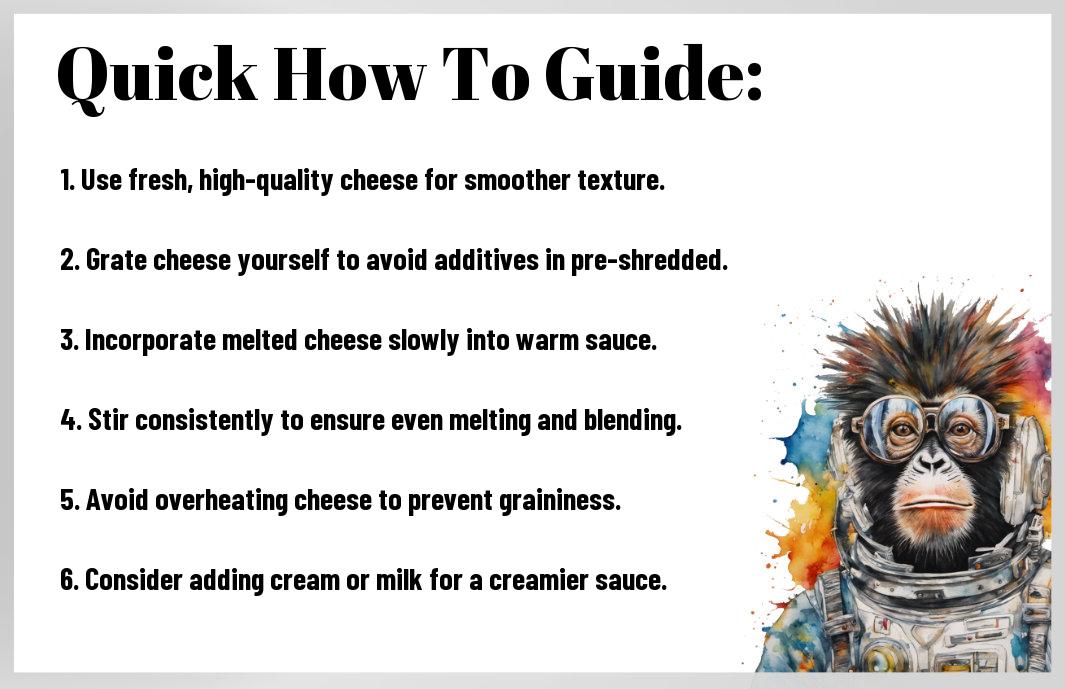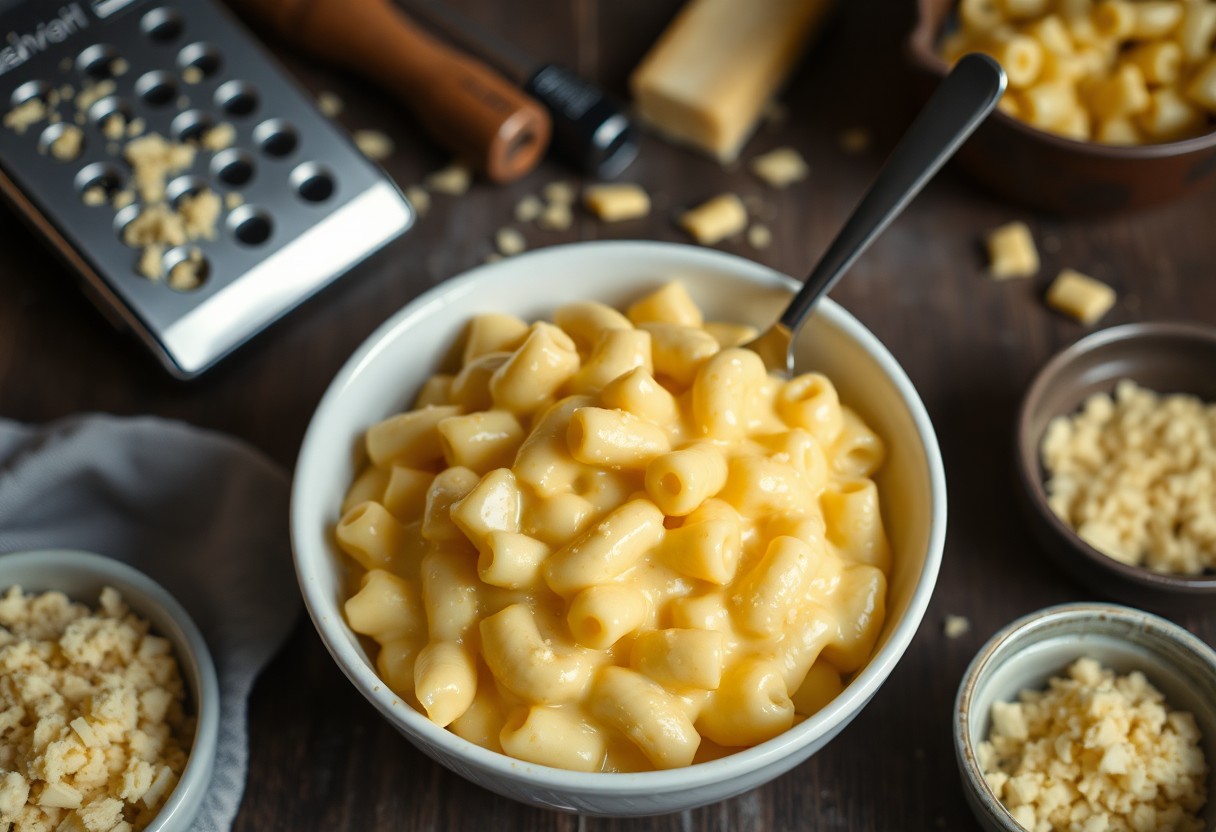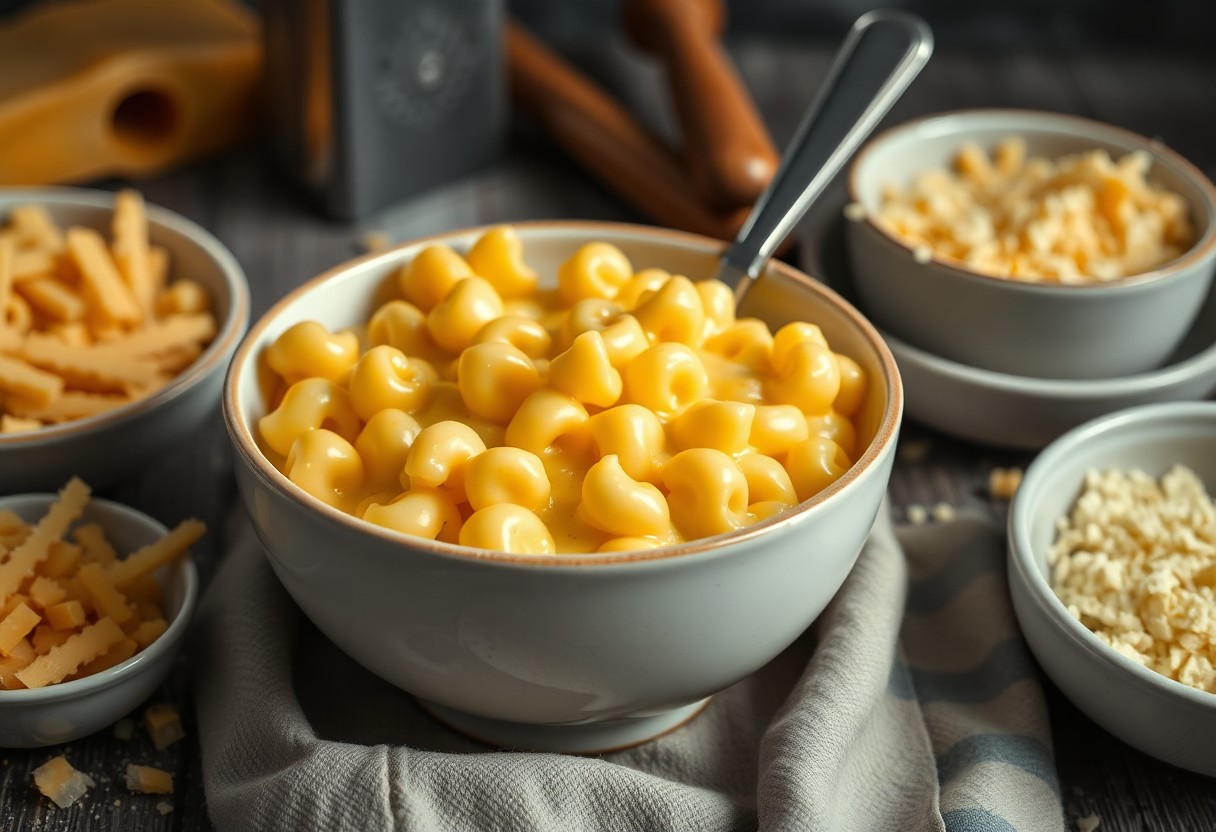Over time, you may have noticed that your homemade mac and cheese can sometimes turn out gritty instead of creamy and smooth. This unwanted texture can be caused by various factors, but luckily, you can easily fix and prevent it. In this post, we’ll examine into the common culprits behind gritty mac and cheese and provide you with effective solutions to ensure your dish remains the comforting, velvety delight it’s meant to be. Say goodbye to graininess and hello to perfect pasta perfection!
Key Takeaways:
- Grittiness in homemade mac and cheese often results from the cheese not melting properly, which can occur if the cheese is overcooked or if it is low-quality. Using a combination of high-quality cheeses, especially those that melt well, can help achieve a smoother texture.
- Adding the cheese gradually to a well-prepared béchamel sauce (butter, flour, and milk) can prevent clumping and ensure that it melts evenly, helping to avoid a gritty finish.
- Using freshly grated cheese rather than pre-shredded cheese, which often contains anti-caking agents, can significantly improve texture and flavor, leading to a creamier mac and cheese.

Understanding Grittiness in Homemade Mac and Cheese
While making homemade mac and cheese can be a delightful experience, grittiness can detract from its creamy, comforting texture. This unpleasant texture often arises from a variety of factors, including how cheese is handled, cooked, and combined with other ingredients. Understanding the sources of grittiness will help you create a smoother and more enjoyable dish.

Common Factors Contributing to Grittiness
Even experienced cooks can encounter grittiness in their macaroni and cheese due to several common factors:
- Improper cheese selection
- Overcooked cheese
- Inadequate mixing
- High heat during cooking
Knowing these factors can help you troubleshoot and improve your homemade mac and cheese.
The Role of Cheese Quality and Type
Factors like the quality and type of cheese you choose significantly influence the texture of your mac and cheese. Lower-quality cheeses often contain fillers or preservatives that lead to a gritty consistency when melted. It’s best to opt for sharp cheddars or other natural cheeses with a higher fat content for a richer, creamier sauce. Additionally, be wary of pre-shredded cheeses, as they typically contain anti-caking agents that can create an undesirable grainy texture when heated. Prioritizing quality cheese will enhance your dish’s overall flavor and consistency.
How to Fix Gritty Mac and Cheese
Assuming you’ve discovered that your homemade mac and cheese has a gritty texture, there are several steps you can take to remedy the situation. Start by incorporating more moisture, as this can help dissolve the gritty particles. Adding a splash of milk or cream can enhance the creaminess. Additionally, gently reheating the dish on low heat while stirring constantly can help re-emulsify the sauce and improve its overall consistency.
Techniques to Smooth Out the Texture
Any time you encounter a gritty texture, consider using a blender to puree your cheese sauce, especially if it contains dry cheese. This helps to create a smoother consistency. Another technique involves incorporating a cheese sauce thickener like cornstarch or flour, which can help absorb excess grit. Don’t hesitate to tweak your recipe until you achieve that ideal creamy finish!
Adjusting Cooking Methods for Better Results
Clearly, the methods you use during the cooking process can have a significant impact on your mac and cheese’s texture. If you notice grittiness, consider altering your approach in future attempts.
For instance, using lower heat can help prevent the cheese from becoming grainy due to separation. Always add cheese gradually to the sauce while stirring continuously, allowing it to melt evenly. Additionally, make sure your pasta is cooked al dente before combining it with the cheese sauce, as overcooked pasta can leach starch and contribute to a gritty texture. Don’t forget to choose high-quality cheese; processed cheeses often yield better results due to their emulsifying properties. With these adjustments, you will be on track to creating a smooth and creamy mac and cheese!

How to Prevent Grittiness in the Future
Unlike store-bought versions that can mask grittiness with artificial ingredients, making homemade mac and cheese allows you to control every aspect of the dish. To ensure a smooth, creamy texture, focus on the quality of your ingredients, the cooking process, and the tools you use. Proper practices during preparation will help you achieve the ideal, velvety goodness in your mac and cheese without any unwanted grittiness.
Choosing the Right Ingredients
Even though cheese is the star of the show, opting for high-quality, aged cheeses can enhance flavor while reducing texture issues. Aim for varieties that melt smoothly, like cheddar, fontina, or monterey jack. Avoid pre-shredded cheese, as anti-caking agents can lead to a gritty finish. Investing in good ingredients sets the foundation for a creamy mac and cheese experience.
Tips for Proper Cookware and Equipment
Prevent grittiness by using the right cookware to create your mac and cheese. Non-stick pans, heavy-bottomed saucepans, or enameled cast iron can provide even heat distribution, minimizing the risk of burning cheese. Use a whisk for a smooth blend and avoid metal utensils that can scratch your pots. Ensure everything is clean and well-maintained to promote effective cooking.
- Non-stick pans
- Heavy-bottomed saucepans
- Use of a whisk
Recognizing the importance of proper equipment will keep your mac and cheese free from grittiness.
Cookware choice is imperative in creating a perfect mac and cheese. Utilizing a sturdy saucepan or non-stick skillet allows for better control over heat and prevents the cheese from burning. A whisk helps combine your cheese sauce into a smooth consistency, while avoiding sharp utensils that might scratch your cookware is equally important. Always keep your pots and pans in good condition to ensure optimal performance.
- Sturdy saucepan
- Non-stick skillet
- Avoid sharp utensils
Recognizing these factors will help you craft a creamy dish each time.
Importance of Sauce Technique
Not every mac and cheese is created equal, and the technique used in crafting your sauce can make all the difference. A smooth, creamy cheese sauce is necessary to achieving that comforting texture you crave. If your sauce is gritty, it can ruin your entire dish, so mastering the sauce technique is vital for success in homemade mac and cheese.
Crafting the Perfect Cheese Sauce
Any effort you put into creating a well-balanced cheese sauce pays off in flavor and texture. Start with a roux, which incorporates flour and fat, to create a base that will hold your cheese without clumping. Adding layers of flavor through seasoning and gradually introducing your cheese will ensure a luscious result.
The Impact of Gradual Heating
Assuming you want that velvety cheese sauce, the method of heating is critical. Quick, high heat can cause your cheese to separate and become grainy. When you heat your cheese sauce gradually, you allow the cheese to melt evenly, ensuring a smooth texture that blends perfectly with your pasta. Less intense heat helps to maintain the integrity of the cheese proteins, minimizing the risk of gritty clumps forming during the cooking process.
Importance of heating your sauce gradually cannot be overstated. It’s necessary to keep the temperature low, allowing the cheese to melt slowly and evenly. This method prevents your cheese from becoming greasy, achieving a creamy consistency that combines beautifully with macaroni. Moreover, by melting cheese over low heat, you avoid scorching it, which can lead to bitterness. In turn, this careful approach can elevate your mac and cheese to a new level of deliciousness.
Expert Tips for Perfect Mac and Cheese
Many aspects contribute to achieving a flawless mac and cheese. Here are some expert tips to elevate your dish:
- Use high-quality cheese for better melting and flavor.
- Incorporate different cheese varieties for a complex taste.
- Cook your pasta al dente to avoid mushiness.
- Ensure your sauce is smooth before mixing.
- Top with breadcrumbs for added texture.
Recognizing these tips can take your homemade mac and cheese from ordinary to extraordinary.
Adding Creaminess
While you focus on creating a creamy sauce, incorporating ingredients like heavy cream or sour cream can enhance texture. Cheese should be added in stages, allowing each layer to melt evenly. Don’t forget to ask for guidance if you’re experimenting with new combinations!
Flavor Enhancements
Little tweaks can significantly improve your mac and cheese’s flavor profile. Add spices like paprika or mustard powder for depth, or stir in cooked bacon or caramelized onions for an elevated twist.
Enhancements can transform your mac and cheese into a gourmet experience. Consider using garlic powder, cayenne pepper, or even a splash of hot sauce for a zesty kick. These small adjustments can excite your taste buds while maintaining the comfort of the classic dish. Additionally, herbs like thyme or rosemary can introduce an aromatic freshness that complements the creamy base beautifully. So, don’t hesitate to experiment with flavors that resonate with your preferences!
Troubleshooting Common Issues
After you’ve crafted your homemade mac and cheese, you may encounter various texture issues, including that unpleasant grittiness. These problems can often stem from ingredient choices, cooking techniques, and even the cheese itself. By carefully troubleshooting these issues, you can elevate your dish into a creamy delight without any unwanted surprises.
Identifying Gritty Culprits
Little things can lead to the grittiness in your mac and cheese. It’s crucial to look at your cheese selection; pre-shredded or low-quality cheeses often contain anti-caking agents that can result in a gritty texture. Additionally, if you’re using a sauce made with flour, inadequate whisking can lead to uneven melting and graininess.
Solutions for Other Texture Problems
Solutions for texture issues extend beyond grittiness. If your mac and cheese turns out too thick, try adding a bit of warm milk or cream to loosen it up. On the other hand, if it’s too runny, cook it longer over low heat to allow some liquid to evaporate. Tackling these challenges ensures a creamy, enjoyable dish every time.
Another element to consider is the cooking time and temperature. Sometimes, an overly high heat can cause cheese to *separate* and become oily. To prevent this, keep your heat low and allow the cheese to melt gently. Incorporating a small amount of cream cheese or sour cream can also enhance the creaminess of your dish, effectively counteracting any texture problems. By being mindful of these factors, you can transform your mac and cheese into a perfectly velvety experience.
Conclusion
Conclusively, understanding what makes your homemade mac and cheese gritty is vital for achieving that creamy texture you desire. Factors like cheese quality, excessive heat, and moisture levels can contribute to grittiness. By selecting the right cheeses, controlling your cooking temperature, and adding liquids appropriately, you can fix and prevent this issue in the future. Enjoy mastering your mac and cheese recipe to create a smooth and delicious dish that elevates your culinary skills.
FAQ
Q: What common factors contribute to a gritty texture in homemade mac and cheese?
A: A gritty texture in mac and cheese can often be attributed to the use of low-quality cheese, improper cooking techniques, or inadequate blending of ingredients. When aged or pre-shredded cheeses are used, they may contain anti-caking agents that prevent smooth melting. Additionally, if cheese is cooked at too high a temperature or for too long, it can become grainy. Lastly, not enough liquid can also lead to a dry, gritty consistency.
Q: How can I prevent my cheese sauce from becoming grainy?
A: To prevent a grainy texture, opt for fresh, high-quality cheeses that melt well, such as cheddar or Gruyère. Avoid pre-shredded cheese, as it may contain anti-caking agents that affect texture. Also, melt the cheese over low heat and gradually incorporate it into your béchamel (white sauce) to create a smooth consistency. Stir the mixture continuously to ensure even melting and avoid overheating.
Q: What steps can I take to fix gritty mac and cheese after it’s cooked?
A: If your mac and cheese has turned out gritty, you can try adding a splash of heavy cream or milk to the dish while gently reheating it on low heat. Stir continuously to help the cheese redistribute and smooth out. If the texture is severely compromised, consider blending the dish in a food processor to achieve a creamier consistency before serving.
Q: Can the type of pasta used affect the smoothness of mac and cheese?
A: Yes, the type of pasta can influence the overall texture. Pasta that has a rough surface, like elbow macaroni, holds sauce better than smoother varieties. Moreover, ensure that the pasta is cooked al dente before mixing it with the cheese sauce, as overcooked pasta can contribute additional starch that might result in a gritty texture.
Q: Are there any specific brands of cheese that are recommended for a creamy mac and cheese?
A: For a creamy mac and cheese, brands that are known for high-quality cheeses include Cabot, Tillamook, and Kerrygold for cheddar varieties. Look for cheeses labeled “sharp” or “extra sharp,” as they often melt well and provide a rich flavor without becoming grainy. Freshly grated cheese is always preferred over pre-packaged varieties for the best texture and taste.